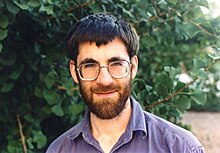Richard Borcherds
Richard Borcherds | |
|---|---|
 Borcherds in 1993 | |
| Born | Richard Ewen Borcherds 29 November 1959[2] Cape Town, South Africa |
| Nationality | British[3] |
| Alma mater | Trinity College, Cambridge |
| Known for | Borcherds algebra |
| Awards |
|
| Scientific career | |
| Fields | Mathematics |
| Institutions | |
| Thesis | The leech lattice and other lattices (1984) |
| Doctoral advisor | John Horton Conway[1] |
| Doctoral students | Daniel Allcock[1] |
| Website | math |
Richard Ewen Borcherds (/ˈbɔːrtʃərdz/; born 29 November 1959)[2] is a British[4] mathematician currently working in quantum field theory. He is known for his work in lattices, group theory, and infinite-dimensional algebras,[5][6] for which he was awarded the Fields Medal in 1998. He is well known for his proof of monstrous moonshine using ideas from string theory.
Early life
[edit]Borcherds was born in Cape Town, South Africa, but the family moved to Birmingham in the United Kingdom when he was six months old.[7]
Education
[edit]Borcherds was educated at King Edward's School, Birmingham, and Trinity College, Cambridge,[8] where he studied under John Horton Conway.[9]
Career
[edit]After receiving his doctorate in 1985, Borcherds has held various alternating positions at Cambridge and the University of California, Berkeley, serving as Morrey Assistant Professor of Mathematics at Berkeley from 1987 to 1988. He was a Royal Society University Research Fellow.[10][8] From 1996 he held a Royal Society Research Professorship at Cambridge before returning to Berkeley in 1999 as Professor of Mathematics.[8]
An interview with Simon Singh for The Guardian, in which Borcherds suggested he might have some traits associated with Asperger syndrome,[7] subsequently led to a chapter about him in a book on autism by Simon Baron-Cohen.[11][12] Baron-Cohen concluded that while Borcherds had many autistic traits, he did not merit a formal diagnosis of Asperger syndrome.[11]
Awards and honours
[edit]In 1992 Borcherds was one of the first recipients of the EMS prizes awarded at the first European Congress of Mathematics in Paris, and in 1994 he was an invited speaker at the International Congress of Mathematicians in Zurich.[9] In 1994, he was elected to be a Fellow of the Royal Society.[13] In 1998 at the 23rd International Congress of Mathematicians in Berlin, Germany he received the Fields Medal together with Maxim Kontsevich, William Timothy Gowers and Curtis T. McMullen.[9] The award cited him "for his contributions to algebra, the theory of automorphic forms, and mathematical physics, including the introduction of vertex algebras and Borcherds' Lie algebras, the proof of the Conway-Norton moonshine conjecture[14] and the discovery of a new class of automorphic infinite products." In 2012 he became a fellow of the American Mathematical Society,[15] and in 2014 he was elected to the National Academy of Sciences.[16]
References
[edit]- ^ a b Richard Borcherds at the Mathematics Genealogy Project
- ^ a b "BORCHERDS, Prof. Richard Ewen". Who's Who 2014, A & C Black, an imprint of Bloomsbury Publishing plc, 2014; online edn, Oxford University Press.(subscription required)
- ^ Goddard, Peter (1998). "The work of Richard Ewen Borcherds". Documenta Mathematica: 99–108. arXiv:math/9808136. Bibcode:1998math......8136G. ISSN 1431-0635..
- ^ "Richard Borcherds".
- ^ James Lepowsky, "The Work of Richard Borcherds", Notices of the American Mathematical Society, Volume 46, Number 1 (January 1999).
- ^ Borcherds, Richard E. (1998). "What is moonshine?". Doc. Math. (Bielefeld) Extra Vol. ICM Berlin, 1998, vol. I. pp. 607–616.
- ^ a b Simon Singh, "Interview with Richard Borcherds", The Guardian (28 August 1998)
- ^ a b c "UC Berkeley professor wins highest honor in mathematics, the prestigious Fields Medal". University of California, Berkeley. 19 August 1998. Retrieved 22 July 2009.
- ^ a b c Jackson, Allyn (November 1998). "Borcherds, Gowers, Kontsevich, and McMullen Receive Fields Medals" (PDF). Notices of the American Mathematical Society. 45 (10). American Mathematical Society.
- ^ Cook, Alan (2000). "URFs become FRS: Frances Ashcroft, Athene Donald, and John Pethica". Notes and Records of the Royal Society. 54 (3). London: Royal Society: 409–411. doi:10.1098/rsnr.2000.0181. S2CID 58095147.
- ^ a b Baron-Cohen, Simon (2004). "A Professor of Mathematics". The Essential Difference: Male and Female Brains and the Truth about Autism. Basic Books. ISBN 0-465-00556-X. (see external links) records conversations with Richard Borcherds and his family.
- ^ High flying obsessives, The Guardian, December 2000
- ^ "EC/1994/05: Borcherds, Richard Ewen". London: The Royal Society. Archived from the original on 8 July 2019.
- ^ Borcherds, Richard E. (1992). "Monstrous moonshine and monstrous Lie superalgebras". Inventiones Mathematicae. 109 (1). Springer Science and Business Media LLC: 405–444. Bibcode:1992InMat.109..405B. CiteSeerX 10.1.1.165.2714. doi:10.1007/bf01232032. ISSN 0020-9910. S2CID 16145482.
- ^ List of Fellows of the American Mathematical Society. Retrieved 10 November 2012.
- ^ National Academy of Sciences Members and Foreign Associates Elected Archived 18 August 2015 at the Wayback Machine, National Academy of Sciences, 29 April 2014.
Further reading
[edit]- Conway and Sloane, Sphere Packings, Lattices, and Groups, Third Edition, Springer, 1998 ISBN 0-387-98585-9.
- Frenkel, Lepowsky and Meurman, Vertex Operator Algebras and the Monster, Academic Press, 1988 ISBN 0-12-267065-5.
- Kac, Victor, Vertex Algebras for Beginners, Second Edition, AMS 1997 ISBN 0-8218-0643-2.
- O'Connor, John J.; Robertson, Edmund F., "Richard Borcherds", MacTutor History of Mathematics Archive, University of St Andrews
External links
[edit]- Richard Borcherds's publications indexed by the Scopus bibliographic database. (subscription required)
- Richard Borcherds's results at International Mathematical Olympiad
- 20th-century British mathematicians
- 21st-century British mathematicians
- Fields Medalists
- Group theorists
- Fellows of the Royal Society
- Fellows of the American Mathematical Society
- Members of the United States National Academy of Sciences
- University of California, Berkeley College of Letters and Science faculty
- 1959 births
- Living people
- People educated at King Edward's School, Birmingham
- Alumni of Trinity College, Cambridge
- Whitehead Prize winners
- International Mathematical Olympiad participants
- British expatriate academics in the United States
